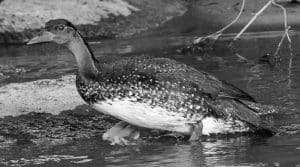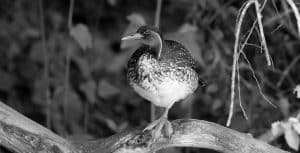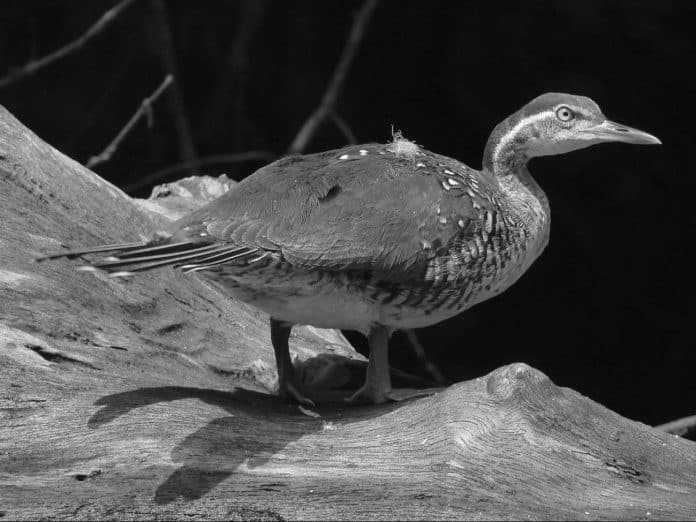Introduction to the African Finfoot
The African Finfoot in Tanzania (Podica senegalensis) is a medium-sized aquatic bird that is found throughout sub-Saharan Africa. They are known for their unique appearance, with a long neck, short tail, and distinctive red eyes. They also have large, webbed feet that are adapted for swimming and diving.
African Finfoots are typically found in slow-moving rivers, streams, and swamps, where they feed on a variety of aquatic invertebrates and small fish. They are secretive birds and are often difficult to spot, as they spend much of their time hiding in dense vegetation along the water’s edge.
Habitat and Distribution of the African Finfoot
The African Finfoot is found throughout sub-Saharan Africa, from Senegal to Ethiopia and down to South Africa. In Tanzania, they are found in a variety of habitats, including rivers, streams, and swamps in the eastern and southern regions of the country.
These birds are typically found in areas with dense vegetation, as they use this cover to hide from predators and to build their nests. They are also known to be territorial, and will defend their nesting sites aggressively against other birds and animals.
Unique Features and Adaptations of the African Finfoot

One of the most unique features of the African Finfoot is its large, webbed feet. These feet are perfectly adapted for swimming and diving, allowing the birds to move swiftly through the water in search of food. They also have long, sharp claws that they use to grip onto branches and other vegetation along the water’s edge.
African Finfoots are also known for their distinctive red eyes, which are thought to play a role in their communication and social behavior. They are highly vocal birds and have a range of calls and songs that they use to communicate with each other.
Conservation Status of the African Finfoot
The African Finfoot is considered to be a species of “Least Concern” by the International Union for Conservation of Nature (IUCN), but their populations are declining in many parts of their range. This is due to a combination of habitat loss, pollution, and hunting.
In Tanzania, the African Finfoot is protected under the Wildlife Conservation Act of 2009, which prohibits the hunting, killing, or capture of these birds without a permit. However, enforcement of these laws can be challenging, and habitat loss continues to be a major threat to the species.
Bird-watching and Spotting the African Finfoot in Tanzania
If you’re interested in spotting the African Finfoot in Tanzania, there are a few things to keep in mind. First, these birds are highly secretive and are often difficult to spot, so patience is key.
The best time to see African Finfoots is early in the morning or late in the afternoon, when they are most active. Look for them in slow-moving rivers and streams, where they are most likely to be found.
Best Time and Locations for Observing the African Finfoot in Tanzania
African Finfoots can be found throughout Tanzania, but some of the best locations for spotting them include the Selous Game Reserve, the Rufiji River, and the Usambara Mountains.
In the Selous Game Reserve, you can take a boat safari along the Rufiji River and look for African Finfoots along the riverbanks. In the Usambara Mountains, you can hike along the Lushoto Forest Reserve and look for these birds in the streams and swamps.
Challenges and Tips for Photographing the African Finfoot

Photographing African Finfoots can be a challenge, as these birds are highly secretive and often hide in dense vegetation. However, with some patience and persistence, it is possible to get some great shots.
One tip is to use a long lens and to approach slowly and quietly, to avoid spooking the birds. Look for areas where the birds are likely to be feeding or preening, and be prepared to wait for the perfect shot.
Other Aquatic Birds of East Africa
In addition to the African Finfoot, Tanzania is home to a wide variety of other aquatic bird species, including herons, egrets, kingfishers, and storks. These birds can be found in a variety of habitats, from coastal wetlands to inland lakes and rivers.
Some of the most notable species include the African Fish Eagle, the Goliath Heron, and the Saddle-billed Stork. These birds are all known for their distinctive appearance and fascinating behaviors, making them a popular target for bird-watchers and nature enthusiasts.
Importance of Protecting the African Finfoot and its Habitat

The African Finfoot is an important species in the ecosystems where it is found, playing a key role in the food chain and helping to maintain the health of aquatic ecosystems. However, their populations are declining in many parts of their range, making it important to protect their habitat and to prevent further declines.
Conservation efforts for the African Finfoot and other aquatic birds in Tanzania include habitat restoration, anti-poaching efforts, and education and outreach programs to raise awareness about the importance of these birds and their habitats.
Conclusion
The African Finfoot is a fascinating and elusive bird species that is found throughout sub-Saharan Africa, including Tanzania. These birds are known for their unique appearance and adaptations, and are a popular target for bird-watchers and nature enthusiasts. By protecting their habitat and raising awareness about their importance, we can help ensure that these birds continue to thrive in the wild for generations to come.

































